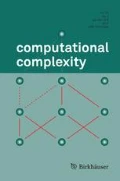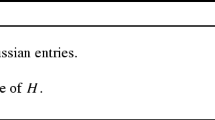Abstract
We extend the techniques developed in Ivanyos et al. (Comput Complex 26(3):717–763, 2017) to obtain a deterministic polynomial-time algorithm for computing the non-commutative rank of linear spaces of matrices over any field.
The key new idea that causes a reduction in the time complexity of the algorithm in Ivanyos et al. (2017) from exponential time to polynomial time is a reduction procedure that keeps the blow-up parameter small, and there are two methods to implement this idea: the first one is a greedy argument that removes certain rows and columns, and the second one is an efficient algorithmic version of a result of Derksen & Makam (Adv Math 310:44–63, 2017b), who were the first to observe that the blow-up parameter can be controlled. Both methods rely crucially on the regularity lemma from Ivanyos et al. (2017). In this note, we improve that lemma by removing a coprime condition there.
Similar content being viewed by others
References
B. Adsul, S. Nayak & K. V. Subrahmanyam (2007). A geometric approach to the Kronecker problem II: rectangular shapes, invariants of matrices and the Artin–Procesi theorem. Preprint.
S. A. Amitsur (1966). Rational identities and applications to algebra and geometry. Journal of Algebra 3(3), 304–359. ISSN 0021-8693.
Atkinson M.D., Lloyd S. (1981) Primitive spaces of matrices of bounded rank. Journal of the Australian Mathematical Society (Series A) 30(04): 473–482
George W. Bergman (1969–1970). Skew fields of noncommutative rational functions (preliminary version). Séminaire Schützenberger 1, 1–18.
Bürgin M., Draisma J. (2006) The Hilbert null cone on tuples of matrices and bilinear forms. Mathematische Zeitschrift 254(4): 785–809
Jonathan F. Buss, Gudmund S. Frandsen & Jeffrey O. Shallit (1999). The computational complexity of some problems of linear algebra. J. Comput. Syst. Sci. 58(3): 572–596.
Marco Carmosino, Russell Impagliazzo, Valentine Kabanets & Antonina Kolokolova (2015). Tighter Connections between Derandomization and Circuit Lower Bounds. In Approximation, Randomization, and Combinatorial Optimization. Algorithms and Techniques, APPROX/RANDOM 2015, August 24–26, 2015, Princeton, NJ, USA, 645–658. http://dx.doi.org/10.4230/LIPIcs.APPROX-RANDOM.2015.645.
P. M. Cohn (1985). Free Rings and Their Relations. L.M.S. Monographs. Acad. Press. ISBN 9780121791506. First edition 1971.
P. M. Cohn (1995). Skew Fields: Theory of General Division Rings. Encyclopedia of Mathematics and its Applications. Cambridge University Press. ISBN 9780521432177.
Cohn P.M., Reutenauer C. (1999) On the construction of the free field. International Journal of Algebra and Computation 9(3–4): 307–323
H. Derksen & V. Makam (2017a). On non-commutative rank and tensor rank. Linear and Multilinear Algebra 1–16. Article in Press.
H. Derksen & V. Makam (2017b). Polynomial degree bounds for matrix semi-invariants.Advances in Mathematics 310, 44–63.
Derksen Harm (2001) Polynomial bounds for rings of invariants. Proceedings of the American Mathematical Society 129(4): 955–964
Derksen Harm, Weyman Jerzy (2000) Semi-invariants of quivers and saturation for Littlewood–Richardson coefficients. Journal of the American Mathematical Society 13(3): 467–479
Domokos M., Zubkov A.N. (2001) Semi-invariants of quivers as determinants. Transformation groups 6(1): 9–24
Edmonds Jack. (1967) Systems of distinct representatives and linear algebra. J. Res. Nat. Bur. Standards Sect. B 71: 241–245
David Eisenbud & Joe Harris (1988). Vector spaces of matrices of low rank. Advances in Mathematics 70(2), 135–155. ISSN 0001-8708.
M. Fortin & C. Reutenauer (2004). Commutative/Non-commutative Rank of Linear Matrices and Subspaces of Matrices of Low Rank. Séminaire Lotharingien de Combinatoire 52, B52f.
A. Garg, L. Gurvits, R. Oliveira & A. Wigderson (2016). A Deterministic Polynomial Time Algorithm for Non-commutative Rational Identity Testing. In Proceedings—Annual IEEE Symposium on Foundations of Computer Science, FOCS, 109–117.
Willem A. de Graaf, Gábor Ivanyos & Lajos Rónyai (1996). Computing Cartan subalgebras of Lie algebras. Applicable Algebra in Engineering, Communication and Computing 7(5): 339–349
Gurvits Leonid (2004) Classical complexity and quantum entanglement. J. Comput. Syst. Sci. 69(3): 448–484
Pavel Hrubeš & Avi Wigderson (2015). Non-Commutative Arithmetic Circuits with Division. Theory of Computing 11, 357–393. http://dx.doi.org/10.4086/toc.2015.v011a014.
Ivanyos G., Qiao Y., Subrahmanyam K.V. (2017) Non-commutative Edmonds problem and matrix semi-invariants. Computational Complexity 26(3): 717–763
Gábor Ivanyos, Marek Karpinski, Youming Qiao & Miklos Santha (2015). Generalized Wong sequences and their applications to Edmonds’ problems. J. Comput. Syst. Sci. 81(7), 1373–1386. http://dx.doi.org/10.1016/j.jcss.2015.04.006.
Kabanets Valentine, Impagliazzo Russell (2004) Derandomizing Polynomial Identity Tests Means Proving Circuit Lower Bounds. Computational Complexity 13(1–2): 1–46
Nathan Linial, Alex Samorodnitsky & Avi Wigderson (2000). A Deterministic Strongly Polynomial Algorithm for Matrix Scaling and Approximate Permanents. Combinatorica 20(4), 545–568. http://dx.doi.org/10.1007/s004930070007.
Malcolmson Peter (1978) A Prime Matrix Ideal Yields a Skew Field. Journal of the London Mathematical Society s2-18(2): 221–233
K. G. Ramanathan (1954). Lectures on the Algebraic Theory of Fields. Tata Institute of Fundamental Research, Bombay.
Aidan Schofield & Michel Van den Bergh (2001). Semi-invariants of quivers for arbitrary dimension vectors. Indagationes Mathematicae 12(1), 125–138
Kai-Tak Wong (1974). The eigenvalue problem λ Tx + Sx. Journal of Differential Equations 16(2), 270–280. ISSN 0022-0396.
Author information
Authors and Affiliations
Corresponding author
Rights and permissions
About this article
Cite this article
Ivanyos, G., Qiao, Y. & Subrahmanyam, K.V. Constructive non-commutative rank computation is in deterministic polynomial time. comput. complex. 27, 561–593 (2018). https://doi.org/10.1007/s00037-018-0165-7
Received:
Published:
Issue Date:
DOI: https://doi.org/10.1007/s00037-018-0165-7




